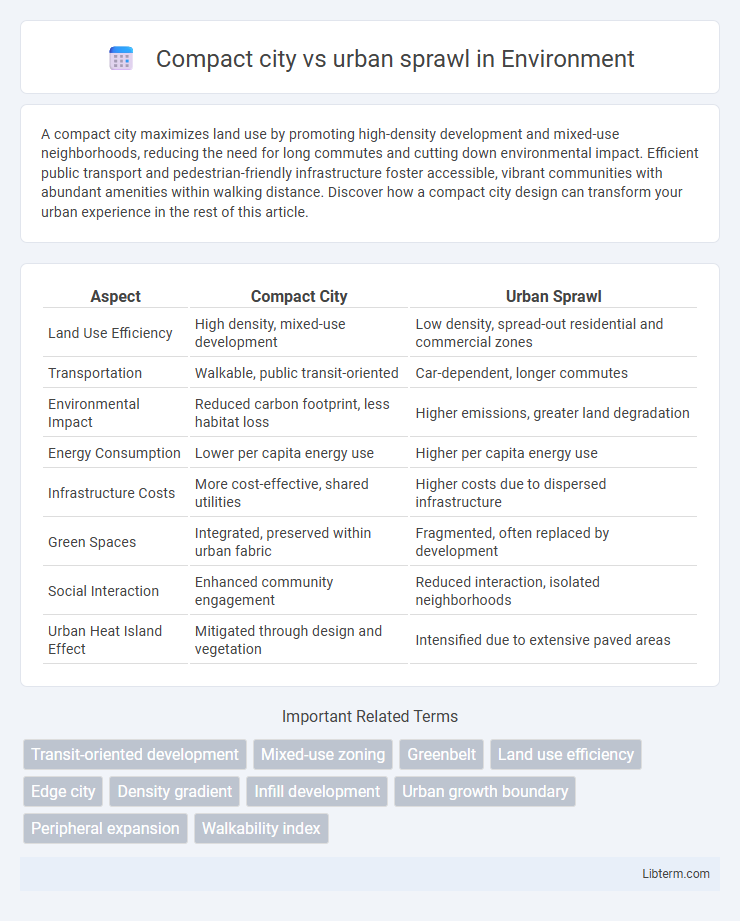A compact city maximizes land use by promoting high-density development and mixed-use neighborhoods, reducing the need for long commutes and cutting down environmental impact. Efficient public transport and pedestrian-friendly infrastructure foster accessible, vibrant communities with abundant amenities within walking distance. Discover how a compact city design can transform your urban experience in the rest of this article.
Table of Comparison
| Aspect | Compact City | Urban Sprawl |
|---|---|---|
| Land Use Efficiency | High density, mixed-use development | Low density, spread-out residential and commercial zones |
| Transportation | Walkable, public transit-oriented | Car-dependent, longer commutes |
| Environmental Impact | Reduced carbon footprint, less habitat loss | Higher emissions, greater land degradation |
| Energy Consumption | Lower per capita energy use | Higher per capita energy use |
| Infrastructure Costs | More cost-effective, shared utilities | Higher costs due to dispersed infrastructure |
| Green Spaces | Integrated, preserved within urban fabric | Fragmented, often replaced by development |
| Social Interaction | Enhanced community engagement | Reduced interaction, isolated neighborhoods |
| Urban Heat Island Effect | Mitigated through design and vegetation | Intensified due to extensive paved areas |
Defining Compact Cities and Urban Sprawl
Compact cities prioritize high-density development, mixed land uses, and efficient public transportation to reduce travel distances and promote sustainable living. Urban sprawl refers to low-density, car-dependent expansion with segregated land uses, leading to increased infrastructure costs and environmental degradation. Defining characteristics of compact cities include walkability and resource efficiency, whereas urban sprawl often results in fragmented landscapes and loss of open space.
Historical Evolution of Urban Forms
The historical evolution of urban forms reveals a transition from dense, compact cities in ancient and medieval times to sprawling suburbs in the modern era driven by industrialization and automotive advancements. Compact cities emphasize high-density development, mixed land use, and public transit accessibility, promoting sustainable growth and reducing environmental impact. In contrast, urban sprawl features low-density, car-dependent development with segregated land uses, leading to increased infrastructure costs and significant ecological footprints.
Land Use Patterns and Density
Compact cities exhibit higher land use density by concentrating residential, commercial, and recreational areas within a limited geographic space, promoting walkability and efficient public transportation. Urban sprawl involves low-density, spread-out development that consumes large land areas, leading to fragmented habitats and greater dependency on automobiles. Elevated land use intensity in compact cities supports sustainable resource management, while urban sprawl contributes to increased infrastructure costs and environmental degradation.
Environmental Impact and Sustainability
Compact cities reduce environmental impact by minimizing land use and preserving green spaces, which supports biodiversity and decreases carbon emissions through shorter travel distances and increased use of public transport. Urban sprawl leads to higher energy consumption and greater greenhouse gas emissions due to reliance on private vehicles and extensive infrastructure development. Sustainable urban planning favors compact city models to enhance resource efficiency, reduce air pollution, and promote resilient ecosystems in the face of climate change.
Transportation and Mobility
Compact cities promote efficient transportation systems by encouraging public transit, walking, and cycling, reducing reliance on private vehicles and lowering traffic congestion. Urban sprawl leads to increased car dependency, longer commutes, and higher greenhouse gas emissions due to dispersed development and inadequate transit options. Investments in compact, mixed-use neighborhoods improve mobility, accessibility to jobs and amenities, and overall urban sustainability.
Economic Implications for Cities
Compact cities promote economic efficiency by reducing infrastructure costs, enhancing public transit viability, and fostering higher productivity through proximity of businesses and labor markets. Urban sprawl leads to increased expenses in road maintenance, utilities, and emergency services, burdening municipal budgets and reducing public investment capacity. Concentrated urban development supports higher property values and attracts businesses, while sprawling areas experience fragmented markets and slower economic growth.
Social Cohesion and Quality of Life
Compact cities enhance social cohesion by promoting walkability, mixed-use developments, and accessible public spaces that encourage community interaction and reduce social isolation. Urban sprawl often leads to fragmented communities, increased reliance on cars, and limited access to amenities, negatively impacting quality of life by increasing commute times and reducing opportunities for social engagement. Higher density in compact cities supports better public transport and local services, contributing to improved health outcomes and a stronger sense of belonging among residents.
Infrastructure and Public Services Efficiency
Compact cities optimize infrastructure and public services by concentrating development within smaller geographic areas, reducing the need for extensive transportation networks and enabling efficient utility distribution. Urban sprawl increases infrastructure costs significantly due to dispersed settlements, leading to longer travel times, higher energy consumption, and challenges in providing consistent public service coverage. Efficient public services such as transit, waste management, and emergency response benefit from the density and proximity inherent in compact urban designs.
Urban Planning Policies and Governance
Urban planning policies promoting compact city development focus on mixed-use zoning, efficient public transportation, and green space preservation to enhance sustainability and reduce carbon emissions. Governance frameworks in compact cities emphasize coordinated land-use regulations and community participation, ensuring balanced growth and resource management. In contrast, policies allowing urban sprawl often lack stringent controls, resulting in fragmented infrastructure, increased car dependency, and higher environmental costs.
Future Trends and Urban Development
Future trends in urban development emphasize compact cities to reduce environmental impact, improve public transportation, and enhance walkability, thereby promoting sustainable growth. Urban sprawl often leads to increased carbon emissions, higher infrastructure costs, and loss of green spaces, making compact urban forms more favorable for climate resilience. Innovations in smart city technology and mixed-use developments are driving the shift towards denser, more efficient urban areas that balance economic growth with ecological preservation.
Compact city Infographic

 libterm.com
libterm.com